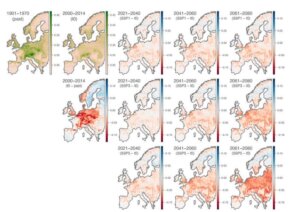Projected decline in European bumblebee populations: an inter-university study published in Nature
“What we’re seeing more and more is a massive disappearance of many bumblebee species, with communities that are much less diverse than they were a hundred years ago“, explains Dr. Guillaume Ghisbain, researcher and lecturer in the Department of Zoology at UMONS. This observation is based on the collection of thousands of specimens throughout Europe, and beyond.
The researchers demonstrate coherent declines in bumblebee populations since 1900 over most of Europe, and identify future large-scale range contractions of bumblebees habitats and species extirpations under future climatic and land use scenarios.
Around 38-76% of European bumblebee species currently classified as ‘least concern’ are projected to undergo losses of at least 30% of ecologically suitable territory by 2061-2080 compared to 2000-2014. All scenarios highlight that parts of Scandinavia will become potential refugia for European bumblebees, but it remains uncertain whether these areas will remain clear of additional anthropogenic stressors not accounted for in current models.
Their results underline the critical role of climate change mitigation policies as effective levers to protect bumblebees from man-made transformation of the biosphere.

Habitat degradation and climate change are jointly acting as primary causes of wildlife collapse, with mounting evidence that this erosion of biodiversity will accelerate in the following decades. In a new study published in Nature, a group of Belgian researchers quantified the past, present, and future ecological suitability of Europe for bumblebees, a threatened group of pollinators ranked among the highest contributors to crop production value in the northern hemisphere. To this end, the researchers employed a machine learning approach to train ecological niche models on more than 400,000 georeferenced occurrence records.
The authors demonstrated that last decades were marked by a notable decrease in ecological suitability mostly concentrated in central Europe, as well as a continental-scale drop in bumblebee species richness below 55°N (the latitude of Copenhagen). They also find that the current risk assessments of the examined bumblebee species are too conservative, and not reflective of their projected population trends, with several species presently listed as ‘least concern’ projected to undergo acute decreases in the spatial extent of their ecological niche. While under all the analysed scenarios Scandinavia appears as an ecologically suitable refugium for European bumblebees, its potential for acting as such will rely on an intrinsic ability for species to disperse, colonise, and successfully maintain viable populations across these territories.
Furthermore, it remains uncertain whether the identified Scandinavian refugium will remain cleared of additional co-occurring anthropogenic stressors that are not considered in the study models.
The authors conclude that subsequent conservation measures will have to be applied hand in hand with stringent global policies aiming to mitigate the human footprint on such vital ecosystem providers, incorporating strengthened regulations on the greenhouse gas emissions and landscape management at national and continental scales.
Read the Nature article here.




